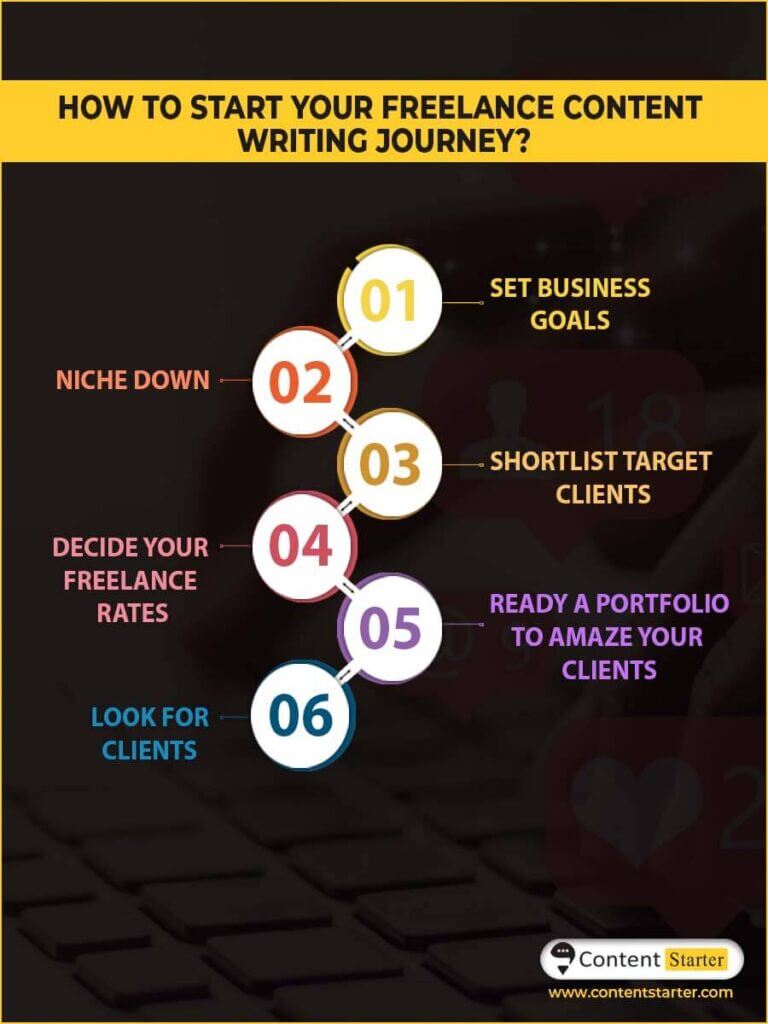How to be a freelance content writer with a full-time job
So you have decided to freelance with a full time job, but you don’t know where to start or are experiencing problems. Well, you are not alone; many full-time workers want to supplement their income due to their rising expenses and therefore decide to freelance with full time job as content writers to do so. People who choose part-time freelance content writing are either content writers or different professionals willing to explore content writing and see if it fits them. Freelancing is also great if you want to switch careers but don’t know if it is profitable or not. It is also great for full-time content writers who want to be their boss but don’t know if it can earn them more money than their current jobs.
Whichever category you fall into, you are all welcome to know how to be a content writing freelance with a full time job.
How to start freelancing
It’s no use to dump information on you without giving you any actionable. Therefore, here are the steps that will help you build a strong foundation and give you the steps to take the information and use it in your life.

Set business goals
Freelancing as a content writer is a business, whether part-time or full-time. Thus, have a tentative future for your business, irrespective of the time you are putting in.
Will being a freelance content writer always be a side job, or do you want to make it a full-time career?
Many people enter the freelancing route for many reasons, and one of them is making extra bucks. However, if you have entered the freelancing path to make big money and eventually plan to convert it into a business, be honest with yourself right now because your approach towards freelancing will be different compared to others. You would not only be working with clients but also gauging the long term potential of the client. You would need extensive networking and attend events to meet new people, possible mentors, clients, or a business partner. Thus, make your mind whether you want to expand your small solo business into a big business with multiple moving parts and high revenue in the future or not.
Do you just want to try out content writing, like people try clothes at a store? If you aim to gauge whether it is the right fit for you or not, you will network and onboard clients in a different manner. You would network with other freelance content writers and ask them about their experience and what is working for them. Your client selection will change too since you will take clients from different industries for a short period. Since you aim to just judge whether it is for you or not, you need to sample as many industries as possible. You would have a better idea if you like content writing at all, and if you do, which industry is your favourite.
If you are a content writer in a specific niche and want to explore other niches, your aim would be different. Your purpose would be to leverage your existing skill set as a writer and pitch to other industries as a freelance content writer without compromising your rates. You may even start to offer a diverse set of services like social media writing, email writing, blog writing, website content writing, etc.
If you aim to earn more money and quit your current job, your approach will be different too. You would aim to find high-paying clients on a long-term basis, so there is a consistent money flow. Moreover, you would need to balance work, freelancing, and personal life, so you need excellent time management.
They might seem trivial, but they are all crucial questions to answer before you start working as a freelancer. Why? Because clarity about your goals will help you reach them faster. Moreover, if any opportunity arises that aligns with your plan, you should take it. Furthermore, freelancing is an emotionally and physically exhausting process, especially with a full-time job. There will be times when you want to quit, and therefore you need to ask yourself if stopping will get you closer to your dream or not. If yes, you can happily leave and continue working where you are, but if quitting takes you away from your plan, should you stop? Probably not.
One more crucial factor you should consider when setting goals is your and your family member’s mental and physical health. We all work to provide ourselves and our loved ones with a comfortable life. Therefore, if your mental or physical health is suffering, you should look past your goals and choose your health. Being ambitious and driven is excellent, but toxic hustling is not. Therefore, step aside for a while, get better and get back into the saddle.
Niche Down
Niching down is the only way of going up financially. If your aim is the opposite of niching down- exploring content writing as a career, you should still choose five topics at most and strategize further on how to get clients. I have always been a proponent of niching down due to the various benefits one gets once they niche down. One of the benefits is the ease of pitching to clients. Since you are writing for a niche, your samples will be relevant for the client, and therefore when you pitch to the said client, they have a better chance to assess your skills and hire you.
Moreover, you can dive deep into the niche and gain a foundation of knowledge on it. Your research process will become easier and faster, and over time your efforts will have a compounding effect, and you can charge higher in the future.
One key point you must remember when choosing a niche is to pick a niche that won’t violate your current contract with your employer, especially when working as a content writer at your current company. Suppose you work in a fintech company and your company has a non-compete clause. A non-compete clause in a contract signifies that the employee isn’t supposed to work for another company in the same industry. Therefore, you need to change your niche to continue to offer the same services. Later in the blog, we will discuss the legalities and ethical aspects of working with a full-time job.
Shortlist target clients
Now that you are aiming for a particular niche, it is time to decide which clients you will look for within that niche. Why? Because the more you know about the target clients, the better you can prepare your strategy to find them and pitch to them. So will your clients be big businesses, small businesses, startups, or other freelancers? You can target one or two clients and shape your client acquisition strategy accordingly.
You can also choose target clients from a specific age group. If you want to have fun and quirky projects, you should look at millennial or GenZ run businesses.
Further, you can select clients via location. Do you want Indian clients or US clients? Indian clients pay less, but it is a market you are familiar with and therefore can write easily. However, the American clients pay higher, but you have to ensure that you use the American spelling and bring and include local references. Therefore, the latter would require more work from your side.
You may even want to work with only female entrepreneurs because you want to support their businesses. Therefore, you need to pick the clients accordingly.
The clearer you are about your target clients, the more effective you can prepare your portfolio and pitch to your clients. Moreover, the specific you are, the higher your chances of being an expert and getting hired.
You can expand your client base if you want to serve another set of clients after a while. The choice, however, is ultimately yours. It’s one of the perks of freelancing; you have more flexibility regarding the clients and work you want to do.
Decide your freelance content writer rates.
A rate card is challenging since there are no standards for freelancers. However, you can set your service rates with a bit of help from other freelancers and some tools. Since you are doing this outside of work, the time you can dedicate is limited, and therefore you need to charge in a way where you do not get burned out and earn enough money in that little time.
Coming back to deciding what to charge, you need to keep in mind that your service charges depend on your:
- Experience
- Education
- Niche
- Location of your clients
- How much do your services contribute to the revenue of the company
The more experienced and education you have, the more you can charge for your services. Moreover, technical niches like health, medicine, technology, fintech etc., have higher pay than other niches. Why? Because they need accuracy and more research. Thus, your niche choice dictates how much you can charge for your service.
Your client’s location matters too because as an Indian freelancer, you make more money when you work with international clients. Since they are accustomed to the gig worker culture, they are more professional and pay you your due without much hassle. However, I am not saying that Indian clients are less professional or a hassle to work with; lousy and good clients exist everywhere. But, working with international clients can help you scale your business for sure. If you have no clue about approaching international clients but want to work with them, we have a detailed guide on working with international clients here; you can check it out.
Now that you understand which factors affect your income, you need to see how much your peers are getting paid and how much you should charge for your service. If you do not know how to conduct this research, you can check our blog on how to become a high-paid freelance content writer; it has a detailed process of how to price your services, so you are not over or undercharging for your assistance.
Ready a portfolio to amaze your clients
So far, you have made business goals, picked a niche, know who you want to work with, and have the price of your service ready; you need to amaze your clients with your work. And therefore, you need to prepare a portfolio of your work. Making a portfolio is challenging and scary. However, it is one of the critical things to do as a freelancer. If you make your portfolio well and establish a rock-solid and consistent social media presence, leads will come pouring in instead of you chasing them.
However, the process of making a portfolio is a vast topic. Therefore we have a blog dedicated to building a portfolio (yes, it is that important to your freelancing journey). You can check out the blog here.
Look for clients
You are all set; now you just gotta look for clients. There are several ways of doing it; you have to experiment with them to see which one gives you the maximum output for minimum input. Since your goal is to work for less time and still get good results, you should generate more inbound leads than outbound leads. What are inbound leads, and what are outbound leads? Inbound leads are the prospective clients who come to you for your services instead of you reaching out to clients and asking if they need your services. The former is better because you get clients already looking for freelancers; however, you need to be proactive for at least an hour every day to attract these clients.
Social Media
Social media is one of the best ways to get inbound leads. Social media is not just a place where people come to brag about their vacations and clothes. Businesses also want to reach their customers and look for talented minds that can help them get those customers. I have started seeing so many paid ads by companies looking for content writers, thus do not discount social media as just a place for chilling and sharing your life with your friends.
But there are many social media platforms; which one do you choose to attract clients? I have a well-defined guide that explores attracting clients via social media in detail. You can check 6-Steps To Find Freelance Content Writing Jobs On Social Media by clicking on it.
Cold emailing
However, for some niches and clientele, social media might yield low results, and therefore you should supplement your existing social media strategy with a cold emailing one. A cold email is emailing a person you have known or met for an opportunity. Since it is a vast topic and requires some in-depth explanation, we have a separate blog called 10-Step Guide Of Cold Emailing that you should definitely check out to understand how to write the perfect cold email and increase your chances of getting a reply.
Avoid burnout while working 10+ hours.
When you work full-time and freelance too, you work more than 10+ hours, which can lead to burnout, especially when one of them is a high-pressure job. Thus, you need to keep your mental health in mind when you take up freelance work. Our bodies are intelligent and start giving us signs of going downhill. Listen to your bodies’ cues like low levels of energy, unwillingness to do work, low motivation, etc. Take a chill pill or a pause from work before it gets worse (and it will get worse, burnout is no joke). It can also mean not working on weekends or taking a week off to focus on things you love doing.
If you feel you are in the middle of burnout or are heading towards one, our blog Complete Guide To Writer’s Burnout. It is possible to have the career of your dreams while also staying mentally healthy; you got this.
Balancing freelance with a full time job
Read your contract
Every time we join a job, HR brings a contract for us to sign that states their policies, and you should be supposed to comply with it to continue working. Many of us sign it without reading it correctly or reading it and forget about it. Now, you’ve gotta dig the contract out and read the fine print. Why? Because not many employers are okay with their employees working.
Moreover, if you have a non-compete clause in your contract, it means you cannot work for your company’s competitors for at least a year. And if you breach your content, you can be sued by the company, and nobody wants that. Therefore, read your contract and make sure there is no non-compete clause or other condition that stops you from freelancing.
Have a hard conversation
Nobody likes hard conversations and confrontations, but you need to have one with your manager or HR about your decision to start freelancing. You may think you can hide your freelance career, but since freelancing involves you being active on the internet, your boss will find out sooner or later, and it won’t be a pleasant conversation.
So, you need to arrange a meeting with your boss and talk to them about your decision to freelance and how it won’t affect your job. You can briefly explain that you need some extra cash or try something new.
You can also offer that your services and/or niches will be different. Therefore it won’t affect the brand. You don’t need to get into details about your clients and what they pay you. But, clearly stating your services and niche to your boss will help them understand that there will be no conflicts with the company’s work.
If the conversation ends on a sour note, drop the idea of freelancing for now. Once you change jobs and your future employer is okay with freelancing, you can start your freelancing journey.
Bring forth the big guns
If your conversation is going in the right direction, you can also bring out the big guns and say how much freelancing will help your current job role. You can say that your content writing freelance career will help your communication skills which are vital in every job. The fact that freelancing will help you develop new skills like negotiating and client servicing, to name a few, shows that you are willing to take extra steps to expand your skillset. You can use freelancing to show your work ethic, and your hardworking ability is a plus for them.
Work hard
Once your bosses are okay with you freelancing, you must keep your work performance the same as before. It is a tricky minefield to navigate since any dip in your performance will bring up the topic of your freelancing. Thus, you need to be proactive at work and keep your performance consistent.
Maintain strict boundaries
Never do your freelance work during work hours, even when you have some extra time left. Use that time to do other miscellaneous tasks but never use company resources for your side project. Moreover, if you have a company-issued laptop, do not use it for your freelancing. Use another system for it because it is not morally ethical. Moreover, keep shop talk at home and not bring it to your office. Do not discuss your clients with your colleagues because the grapevine is strong, and it may eventually reach your boss’ ears that you are talking about your side hustle in the office. Draw boundaries with your clients, too, to not call you during work hours.
Why keep boundaries? Because it will help you make fewer mistakes (attaching wrong files to the wrong people can cause a stir). Moreover, it will show you are a professional who keeps to your words and can draw boundaries. Moreover, maintaining boundaries will also signal that you keep the two aspects of your life separate, and they shouldn’t intrude on your off-work hours.
Conclusion
You are ready to balance your full-time job and freelancing like a boss. Freelance with a full-time job is challenging, but it can change your life if done with care and correct time management. As a freelance content writer, you make some extra cash and learn crucial skills that will help you in every career you choose. There are tons of part-time content writing jobs waiting for you; go ahead and grab the opportunities, and you never know; you may just be a talented writer. Many freelance content writers have left their full-time job because they found the career satisfying financially and professionally. You never know if it can be you or not, so take a chance and dip your toes into the vocation of content writing.
And if you are looking for a guide to help you, you can follow Content Starter on Instagram, Facebook, Pinterest, and Twitter. We always come through with quality content to help freelance content writers like you!





